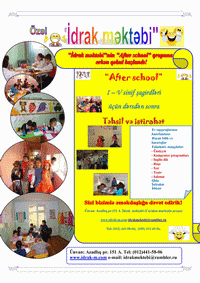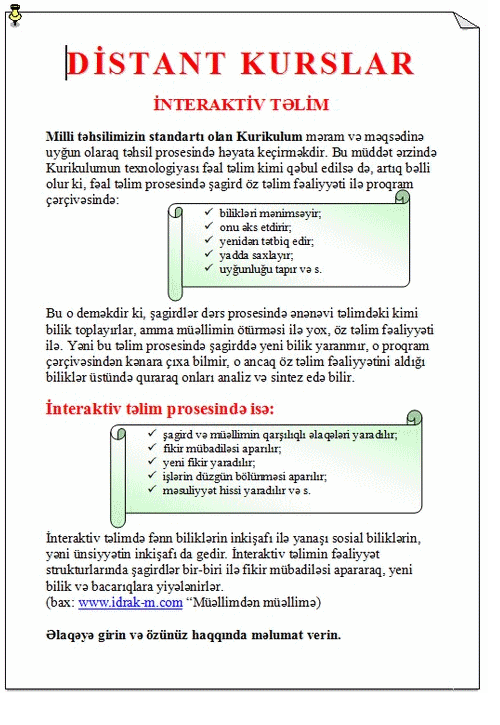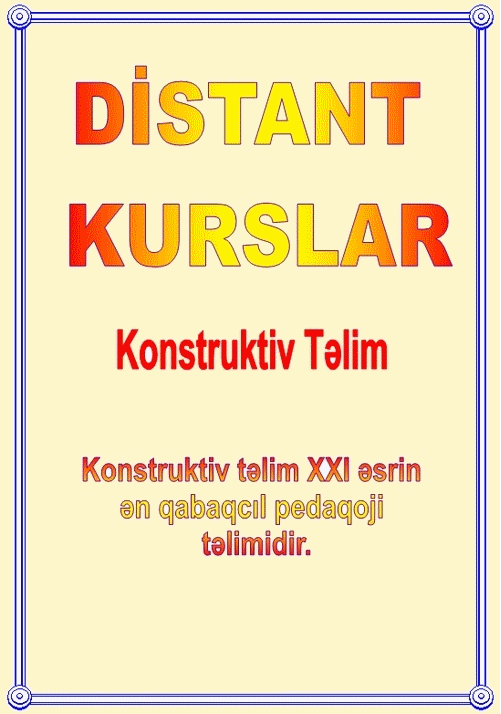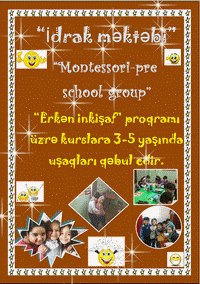New Strategy of the Distance Education
Fatma Khanim Bunyatova1,*, Gulbala Salamov2 1
Intellect School, Baku, Azerbaijan 2Department of Computer Education & Instructional Technology, METU, Ankara, Turkey
*Corresponding Author: fatmaxanum@rambler.ru
Copyright © 2014 Horizon Research Publishing. All rights reserved.
Abstract This article is dedicated to new strategy of distance education.http://files.eric.ed.gov/fulltext/EJ1053819.pdf The article deals with the possibilities of ICT (Information and Communication Technologies) in teaching specially distance education. In the article, ICT technological tools and their methods of application in educational process are looked over; discrepancy of intellectual approaches of technologies with methods and ways of teaching is found out. It is offered to change education strategy to improve quality of distance training. New strategy of education contains three main directions: Formal-logical and Fuzzy Logics modeling of knowledge; cognitive approach in training and new criteria of evaluation of students’ knowledge. Keywords Distance Education, Formal-Logical Model Of Knowledge, Fuzzy Logics Model of Knowledge, Structures of Knowledge, Invariant and Variable Knowledge, Set Element, Universal Set, Linguistic Variable
1. Introduction
Information and communication technologies are widely applied in education. Technical means of ICT formed new directions in training as e-learning, m-learning, on-line learning, distance education. One of these directions — distance education, appeared on the basis of the correspondence education and nowadays has become popular in the general education. Owing convenience and flexibility, it eliminates many problems of pupils: problems with health, problems of the remote place of residence from schools, etc. Being trained remotely, one can choose convenient time for occupations according to own schedule and own rate of training. To provide effective interaction for students at distance learning a full tool kit, including interactive computer programs, Internet, e-mail, Skype, Face book, a video-telephone, etc. is used. But this set of technological tools isn’t used completely for receiving qualitative education. Application of technology helps only effective interaction among students and to choose freely time and place for training. The reason of dissatisfaction with the quality of education is the fact that these computer programs consist of learning materials of traditional training, training by transferring private, unsystematic, illogical knowledge. The competence of learners in this way of learning shall mean knowledge, skills and capacity inadequately meeting the demands of the 21th century. Astechnology-base deducation, distance learning shall — within the framework of knowledge – include such transforming criteria as analysis, synthesis, creatively applying individual knowledge and transforming them, and generation of new knowledge. In order to have the learners acquired these intellectual and practical abilities, a new strategy of distance learning shall be built. To increase quality of distance education, it is necessary to set up a new strategy of distance education.
2. Why is the New Strategy of the Distance Education Necessary?
First, technological tools of knowledge applied in distance learning are based on artificial intelligence. The artificial intelligence has been created on the basis of the Zadeh’s theory of natural intelligence of Piaget. If tools of knowledge are created according to artificial intelligence, then the knowledge which should be studied by means of these tools have to be logically created according to the development of natural intelligence. It means that subject knowledge in distance education has to be modeled logically on the basis of Zadeh’s fuzzy logics [2002]and Piaget’s logical integrity [2001] Second, these two tools of knowledge — artificial and natural, have the developing mechanisms and instruments of actions over knowledge. If each student uses these developing mechanisms and instruments of action over knowledge in the course of learning, personal knowledge will be converted and built into a new form. This form will develop in the thinking of every student and generating process.
During the course of this process it is impossible to use a traditional way of knowledge transfer. The cognitive way of training has to be applied where there is a process of creation of knowledge. So, learning strategy has to be constructive both in cognitive and in the social direction. The third criteria of evaluation of knowledge here expand as the action including thinking and a social interaction. That is why not only knowledge, but also intellectual (cognitive) and social skills and abilities will be estimated. Implementation of this strategy of learning may lead to radical changes in education. Not transmission of knowledge and applying of them and the level of maintaining them, but each learner’s intellection and action, and creativity and self-realization shall be prioritized in the learning process.
3. Logical Modeling of Knowledge
The logical model of knowledge is built structurally. Each unit of knowledge in the model will be considered as the structure of knowledge. These structures of knowledge are indexed. According to Piaget logical integrity, indexation is considered as a logical operation of intellection. The model of knowledge is formed in two forms:
1. In the form of natural intelligence by means of psychological concepts of logic integrity of Piaget;
2. In the form of artificial intelligence with the mathematical concepts of fuzzy logics of Zadeh;
Both these forms of knowledge models contain the same. The difference is that in the first model, the content of knowledge is modeled by psychological integrity of Piaget’s concepts of logic, and the second model by mathematical concepts of Zadeh’s indistinct logic. The first form of the model – a logic-integrated model of knowledge is necessary for programming knowledge. The second form of the model — indistinct model is necessary for computer programming of this knowledge. As a result, the logical model of knowledge consists of formal-logical and fuzzy logics model of knowledge.
4. Formation of Integrated Logical Model of Knowledge
This model is under construction on concepts of logic of natural intelligence of Piaget – logicians of integrity. Didactic units of knowledge are considered from the position of knowledgestructures.(http://mto.ru/filologiya-russkogo-yazyika/strukturalizm.html) In this model Structure of subject knowledge is divided into constant – invariant and categorical variables. On the example of linguistic knowledge the dictionary structure of language, which is classified as parts of speech and the rules relating to each part of speech, concerns constant knowledge. Constant — invariant knowledge is denoted by X. Parts of speech designated as x1, x2, x3, etc. to x10 and placed horizontally on a coordinate plane model. Each x is a cell of constant knowledge i.e. rules of this part of integrated knowledge.
Variable knowledge (in language knowledge it is the category of language) are denoted by U. They are placed on a vertical coordinate plane models and are denoted by Y1, Y2, Y3, etc. Each cell is at all variable knowledge of this category. In this coordinate plane the structures of knowledge are structured in the scheme of integrity. From this scheme of integrity knowledge may exit to private knowledge or to logical structures of knowledge or on the contrary from private knowledge to integrated knowledge. Coordinate plane of knowledge is as lattice of knowledge. In this lattice structure of all the knowledge that is x and y are ordered and knowledge of x structure and y structure have an accurate edge. In the formed model the structure of invariant and variable knowledge is logically combined and detached, attached or annulled. These logical structures of knowledge are called logical structures of Bunyatova’s theory. On the structures of knowledge logical operations of thinking are held: enrichment operation, replacement operation and multiplicative operations. These operations are knowledge tools. Operations of thinking develop these structures of knowledge and convert them to the qualitatively new. Analogical structures of knowledge in thinking are formed during interaction of the students with these tools of knowledge over structures of knowledge. The formed logical-integrated model of knowledge is the genetic program of knowledge. Intellection of a learner becomes operational, as it gets transformed, integrated, enriched, supplied and finds a way of application of the acquired knowledge to the new conditions. The intellection of the learners become mobile and directed towards transformation. The formed logical-integrated model of knowledge is the genetic program of knowledge. On the basis of this program knowledge tools of Zade’s indistinct logic will form indistinct knowledge model.
5. How to Make a Form of Formal-Logical Model of Knowledge
In indistinct model of knowledge – all subject knowledge is considered – as a mathematical set and denoted by – n. In this set of knowledge – knowledge is divided into x and y. On the example of linguistic knowledge the structures of knowledge are understood as the set elements. Each structure of knowledge in this model is considered as the element of the set. Structures of constant – invariant knowledge are identical to Zadeh’s mathematical concept to a universal set, and variables i.e. categorical knowledge correspond to linguistic variables. According to Piaget, the structures of knowledge are invariant variables, while Zadeh finds them as universal-linguistic ones.
Knowledge of a mathematical set is classified and is denoted by х0,1, х0,2, х0,3, etc. to х1 and placed horizontally on a coordinate plane model. Each x is a unit of knowledge of this part of the mathematical set of knowledge. Universal set of knowledge may be finite or infinite according to the classification in the classes. Variable — categorical knowledge or linguistic variable are vertical and are denoted by U. They are also classified and denoted by y 0,1; y 0,2, etc. According to Piaget, the structures of knowledge are variables, while Zadeh finds them as linguistic ones. [2] In [Nordhausen and Langley, 1990] it is noted that the formation of categories is the basis of the unified theory of scientific researches. Denoting classes and groups of the set, and as well as categorical knowledge of a linguistic variable through numbers, we can present this knowledge with their properties. Each property accepts consecutive number. Denoting knowledge through numbers, it is possible to put elements of knowledge in logically consistent position. Logical order of knowledge creates an integrated picture of knowledge. Where one of the units of knowledge is produced inaccurately or misses, it shall be corrected or restored through knowledge integrated to it. Each class of knowledge or element set is considered a cluster (J. Simens, Downes 2011) of structures of knowledge at the same time. They have their rules and laws which are all the time in mobile movement, uniting on the set installation round logical structure of knowledge or an element of the set and turn into nanostructures of knowledge.
6. Criteria of Knowledge Estimation
Criteria of students’ knowledge estimation in integrated and indistinct model of knowledge expand. Together with the estimation of knowledge, level of analytical and synthesized methods of knowledge, level of assessment and generation of new knowledge, level of social interaction will be estimated.
7. What Will Change and We Get at the Implementation of the Strategy of Education in the Learning Process?
When implementing this strategy, distance education will be: The new generation of multimedia textbooks, on the basis of logic integrity and indistinct logic will be modeled; 9. While working with these manuals, intellection of the learners will become mobile, operational and directed towards transformation.
1. New operational targets on the knowledge and methods of use in the educational process of design approaches will be developed; these tasks will create a proper design of cognition in intellection of each learner, which will develop dynamically and get enriched. . New criteria of assessment of minimum and maximum will be created – assessment of development of academic, intellectual and social
skills and capacity;
2. Within these criteria, assessment of each learner may determine its proper level of academic, intellectual and social knowledge.
3. New criteria for assessing the development of knowledge, intellectual and social skills will be obtained;
4. Boundaries of high-quality application of ICT with pedagogical technologies will be expanded; Alterationofthestructureofknowledgeinvestedincomputertechnologies. This will change the quality of integration of ICT into pedagogical technologies and lead to increase the level of understanding, cognition, and transformation and generation of new knowledge. This logical and integrated model of knowledge may be applied to various forms of knowledge. It will generate a considerable change in education: transformation of the school of memory to the school of intellection.
5. Application of this model of knowledge in other areas of education;
6. With the implementation of the education strategy a successful step will be made in learning without a teacher, in self-learning and lifelong education.
REFERENCES
[1] R. Аliyev (1999), Soft Computering, Baku : ANA
[2] F.J. Bunyatova (1990),Logical Way Of Learning. Alternative Education, Baku:Maarif
[3] F.J. Bunyatova(2001)J.Piaje at schoole‘’Scientificresearches’’Baku
[4] F.J. Bunyatova (2002)Use of fuzzy logic in educational technologie, Baku : Copyright Agency Of The Azerbaijan Republic
[5] F.J.Bunyatova (2007) .The Education Ttechnology. The ConstructiveTeaching. Retrieved fromwww.eidos.org
[6] F.J.Bunyatova,Constructive teaching technology and perspectives of Nanopsychopedagogy, International Educational Technology Conference (IETC2009), Ankara, Turkey
[7] A.R.Bunyatova, ‘’Logical Integrity, Fuzzy Logic and Modeling Content of Education’’ AICT-2009, Baku
[8] Lotfi Asker Zadeh (1976),The concept of linguistic variable and its application to the adoption of approximate solutions, Moscow:Mir.
[9] J.Piajete, (2001) The Selected Papers, Moscow
[10] Nordhausen and Langley,Retrieved 2011,fromwww.filosof.historic.ru/books
[11] V.Pivcin, E.Baculin, D.Corenkov,(n.d)Fuzzy sets control. Retrieved June, 2011, fromwww.allmath.ru/appliedmath
[12] J.Simens, Downes, Retrieved 2011,fromwww.letopisi.ru/index.php/
Baxış: 1370







